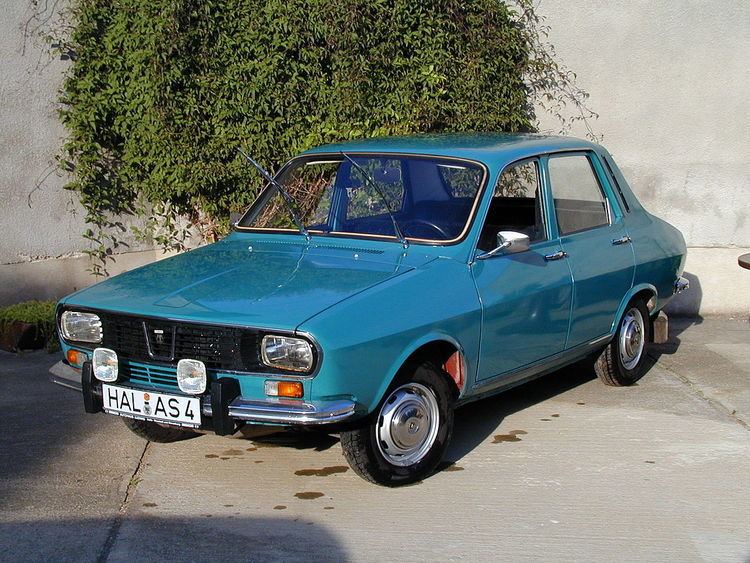Production 1969–2004 | ||
 | ||
Model years 1969–19821982–19841984–19911990–19931994–19991999–2004 Class Large family car (Dacia 1300)Small family car (Dacia 1310) Body style 4-door saloon5-door estate2-door coupé2-door pick up (Dacia Pick-Up 1302/1304/1305)4-door pick up (Dacia Pick-Up 1307/1309) | ||
The Dacia 1300 ([ˈdat͡ʃia]) was (at the time of its launch) a medium-sized family car, built during the Cold War by Romanian auto maker Dacia. The "1300" stands for the engine displacement. The first Dacia 1300 left the assembly line on 23 August 1969. On 21 July 2004 the last Dacia 1310 (sedan version), number 1,959,730, rolled out the gates of the Mioveni production facility, just one month before its 35th anniversary.
Contents
Dacia 1300
The Romanian government of the 1960s had decided to acquire the tooling and basic design of a modern, western automobile, in order to offer their own car to the Romanian people. Terms stated that the vehicle had better not be expensive, large enough for a family, and had to be powered by an engine no larger than 1.3 litres. Offers came from Alfa Romeo, Fiat, Austin and others, but the winner was the Renault 12. The decision towards the French car was probably political to a large extent but sound, nonetheless. Most of the resulting vehicles were sold to consumers in the Communist Eastern bloc and in export markets such as South America, Canada, China, or North Korea, but also Great Britain or the Netherlands. When automobile production started at the Mioveni factory, the Renault 12 was but a prototype, for which reason, Renault offered CKD kits and tooling for the older Renault 8 Major, as a temporary replacement, resulting in the Dacia 1100, for a few years until the much awaited Romanian people's car would arrive. Both the R12 and its licensed copy, were launched in 1969. During the first few years of production, the plant assembled CKD kits imported from France. At the time of its launch, the 1300 was a modern car offering good comfort, safety, good performance and reliability, and even more so by eastern standards of the time, set by 1960's and 70's Skodas, Ladas, Moskwich, Wartburgs and other eastern block industry creations.
The 1300 was subject to multiple facelifts in an effort to maintain consumers' interest in the model, but the basic design was kept for its entire 35-year lifespan. Although performance and fuel consumption were gradually improved, quality didn't always meet the standard once they had stopped importing CKD kits. Bodypanel corrosion became the model's number one problem. Air conditioning, airbags and anti-lock brakes, were never offered.
Multiple pick-ups derived from the original sedan and estate bodies, but also a less popular 2-door coupe and an even rarer liftback.
Dacia 1310 series
In 1979, Dacia presented a revised version of the 1300, at the Bucharest Auto Show.
In 1982, its name was changed into Dacia 1310 and later also came "1410", "1210" and a few others. New versions of Dacia Pick-Up were introduced starting 1981. In 1983 the whole range was facelifted for the 1984 model year. A coupé version of the car, the 1410 Sport, with two doors and a lowered roof, was also released in 1983. In 1985 the drop-side coupé utility (pick up) was introduced and in 1987 the Dacia 1320 liftback. In 1989 the production for the facelifted 1310 sedan, van and estate was over, although the pick up continued until 1990. The 1320 stopped in 1990.
In 1989, a new generation Dacia 1310 was launched in estate and sedan versions. It was a minor modification of the previous generation with new headlights. The liftback named Dacia 1325 Liberta was introduced in 1990. The 1310 van was launched in 1990 and the coupé utility (pickup) versions in 1992. A double cab version of the pickup was introduced, and later also a king cab version. The fully facelifted Dacia 13xx range was introduced in 1993.
Designed in the 1960s, the model was long in the tooth by now and its chassis was no longer able to meet safety standards of the 1980s and 90s. Therefore, Dacia started design for a replacement in the 1980s. However, financial and political setbacks only allowed the replacement to be launched in 1994, by which time it was already outdated, as the Dacia Nova. Later evolving into Dacia SupeRNova and Dacia Solenza. Although faster and displaying better road manners, the Nova never replaced the 1310 range, due to its higher price, smaller interior and other disappointing factors. Nova, SuperNova and Solenza only came in a liftback body. The true replacement only came in 2004 with the Logan.
Although the newer Nova range sold rather well, it was never able to match the demand for the 1310 range, therefore Dacia was forced to facelift the 1310 yet again, in 1999. The Liberta liftback had been dropped in 1996, but production of the sedan and estate was over in 2004. The pick-up versions were dropped in December 2006. The last 1310 model was simply named "Berlina" or "Break", for sedan or estate respectively.
In an effort to keep up with modern standards, the last version was equipped with fuel injection system and a catalytic converter, meeting Euro2 emission standards.
Since 1969 when original model production started, constant change in auto models' shape and size meant that the 1310 was a small-sized sedan by now, even if it had started life as a medium-sized. Oddly enough, for a few months in 2004, Dacia had 3 different small sedan models simultaneously on offer.
The model scored solid sale numbers right up to its last day of production, mainly due to its low price, value for money, easy and cheap maintenance. The sedan ("Berlina") and the estate ("Break") had €4,100 and €4,250 price tags respectively, for the year 2004. The "Pick-Up" range ended production in 2006. Dacia Logan replaced the 1310 range in 2004.
